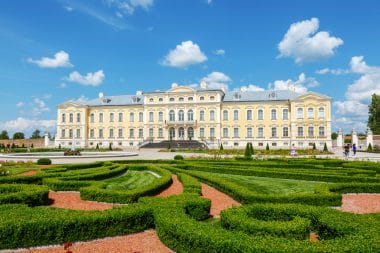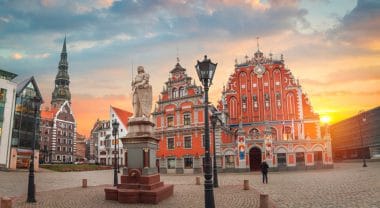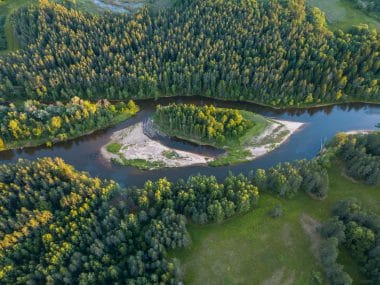Latvia, together with its neighbours Estonia and Lithuania, is located in the 175,000 km² northeastern European region of the Baltic States on the Baltic Sea coast. With an area of just over 64,500 km², the second largest of the three Baltic states currently has almost two million inhabitants in nine so-called “republic cities” and a total of 110 districts.
Riga – capital of Latvia
In the capital Riga in the center of the country , almost 700,000 people currently live on an area of more than 300 km². In terms of landscape, Latvia is a wooded hilly country with numerous bodies of water and a long and flat coastal plain. The highest mountain Gaiziņkaln near the town of Madona (Livonia) measures only 311 meters. Climatically, the country is rather cool and temperate with cold winters below 0 °C and only moderately warm summers with temperatures around 17 °C. On the coast, however, it can also get up to 30 °C in July and August. Latvian history, which dates back to the 12th century, is eventful and eventful, marked by many conquests and occupations. In August 1991, the independence first declared in 1918 was regained. Culturally, Latvia is divided into four historical regions: Livonia in the north, Courland in the west, Latgale in the east and Semigallia in the south.
Livonia: Castles and parks, Swimming and skiing, Culture and nature

The region of about 23,000 km² is located in the north of Latvia on the border with Estonia and includes the counties of Alūksne, Cēsis, Gulbene, Limbaži, Madona, Ogre, Rīga, Valmiera and Valka. The largest and most famous city is of course the Latvian capital Riga, whose carefully renovated city center has been a UNESCO World Heritage Site since 1997.
Particularly worth seeing are the replica of the medieval House of the Blackheads from 1999, the residence of the President of the Republic in Riga Castle from the 14th century and the monumental Freedom Monument from 1935. You can stroll and walk in the two parks Wöhrmannscher Garten and Basteiberg, and many excursion boats also operate on the Daugava River. Other towns worth seeing in Livonia are Alūksne with a spacious castle park from the 18th century, Cēsis with the ruins of the castle of the Teutonic Knights from the early 13th century and Mazsalaca with the Salaca nature reserve. Well-known and popular seaside resorts are Saulkrasti and Jūrmala, and there is a large winter sports area around Sigulda.
Kurzeme: The sea and the coast characterize the westernmost part of Latvia

The 13,600 km² area extends over the western part of the country on the Baltic Sea coast and over the lower half of the Gulf of Riga. In the south, Kurzeme borders Lithuania, the northernmost point is Cape Kolka in the Slītere National Park, which is popular with excursionists and birdwatchers due to the numerous migratory birds that can be seen there in spring. The two largest cities are Liepāja, known for its dune beach, with currently a good 76,000 inhabitants, and Ventspils, including its elaborately restored old town and currently over 38,000 inhabitants.
In Liepāja, you can visit the City Museum, the Occupation Museum, and the Maritime and Fishing Museum. The former Soviet prison in the war port is also worth seeing. Souvenirs can be purchased in the craftsmen’s house and in the market hall “Petersmarkt”. In the city of Ventspils, the 13th-century castle, the open-air museum with old farmsteads, a windmill and a steam-powered narrow-gauge railway, and the beach park with a heated outdoor swimming pool are well-known attractions. Popular destinations in Kurzeme are the seaside resort of Pāvilosta and the scenic Talsi.
Latgale: A lot of lakes as well as Catholic believers and people of Russian origin

The sparsely populated region on the borders with Russia and Belarus in southeastern Latvia has traditionally had a very multicultural character. The 14,500 km² area is currently home to a good 270,000 inhabitants, of whom 150,000 still speak the Latgalian language. Unlike in the rest of the country, the majority of the population here is Catholic, and the proportion of the Russian minority is also very high, up to 80 percent in some places.
Poles and Belarusians are also strongly represented. Typical of Latgale are the many lake landscapes, such as around the more than 26-hectare Lake Rāzna in the almost 600 km² national park of the same name near Aglona, Ludza and Rēzekne. The largest city in the region is Daugavpils with currently around 92,000 inhabitants, and the citadel, built between 1810 and 1833, is particularly worth seeing. Regional attractions also include the historic churches from the 18. and 19th century in Kārsava, the castle of Krāslava, the ruins of Ludza Castle and Latgale Street with many old buildings in Rēzekne. The Forest Museum and Nightingale Island with an open-air stage in Viļānis are also worth a visit.
Semigallians in Latvia: Art in the castle, fishing on the lake and sulphur in springs

The region, which covers about 14,000 km², lies to the left of the Daugava River and borders Lithuania in the south. Zemgale is also known as “Oberland” or “Upper Latvia” (Augšzeme), the largest city in the region is Jelgava with currently almost 61,000 inhabitants. Worth seeing there is first and foremost the largest baroque castle in the entire Baltic States from the 18th century. The magnificent building of the high school “Academia Petrina” also dates from the same period.
The Orthodox cathedral and church “St. Anna & Simeon” was rebuilt between 1993 and 2003. A spa town that has been much visited since the 18th century because of its sulphur springs is Baldone. In Döblen, the ruins of a castle of the Teutonic Order can be visited. Popular destinations for anglers and hikers in the Engure district around Smārde are Lake Engure and Lake Kaņieris in the 38,000-hectare Ķemeri National Park. The castle in Jaunpils was built in the 14th century, Rundāle Palace from 1768 is considered the “Versailles of the Baltics” and is the site of a large art exhibition.
Important information for your holiday in Latvia
Important telephone numbers
- Emergency numbers: 112 (police, fire brigade, rescue service)
- Police: 110
- Ambulance: 113
- German Embassy in Riga: +371 67 08 51 00
German Doctors
- Dr. Guntars Romanovskis: German Medical Center, Baznīcas iela 31-12, Riga, +371 67240737
- Dr. Toms Uldis Andersons: Health Center 4, K. Valdemāra iela 100, Riga, +371 67847100
Important words with translation
- Hello – Sveiki
- Thank you – Paldies
- Please – Lūdzu
- Yes – Jā
- No – Nē
- Sorry – Atvainojiet
- Where is…? – Kur ir…?
- How much does it cost…? – Cik maksā…?
- Emergency – Ārkārtas gadījums
- Doctor – Ārsts
- Hospital – Slimnīca
Holidays
- New Year’s Day: January 1
- Independence Day: May 4
- St. John’s Day (Līgo): June 23
- Midsummer Festival (Jāņi): June 24
- Latvian Legionnaires’ Day: 11 November
- Independence Day: November 18
- Christmas: December 25
- St. Stephen’s Day: December 26
Opening hours
- Shops: Monday to Saturday from 10:00 to 21:00, Sunday often shorter opening hours.
- Supermarkets: Usually from 8:00 a.m. to 10:00 p.m., some also open 24 hours.
- Restaurants: Lunch from 12:00 p.m., dinner from 6:00 p.m. to 10:00 p.m.
- Banks: Monday to Friday from 9:00 a.m. to 5:00 p.m.
Airport
- Riga International Airport (RIX): 10 km southwest of Riga
NUDISM
- Official nudist beaches: Vecāķi Beach near Riga
Post / Stamps
- Post offices (Latvijas Pasts): In all major cities. Opening hours: Monday to Friday from 8:00 a.m. to 7:00 p.m., Saturday from 9:00 a.m. to 2:00 p.m.
- Stamps: Available at post offices, kiosks and supermarkets.
- Costs for letters and postcards to Germany: Standard letter up to 20g: approx. 1.20 EUR; Postcard: approx. 1.00 EUR
Safety
- Crime: Latvia is considered relatively safe. Observe the usual precautions as in any large city.
- Emergency number: 112
Current
- Voltage: 230 volts
- Sockets: Type F (as in Germany)
Tip
- Restaurants: 5-10% of the invoice amount
- Taxis: Round up the amount
- Hotels: 1-2 euros per day for cleaning staff
Customs
- Allowances within the EU: No customs restrictions on personal belongings.
- Alcohol: Maximum 10 liters of spirits, 20 liters of alcoholic beverages with less than 22%, 90 liters of wine, 110 liters of beer.
- Tobacco: 800 cigarettes, 400 cigarillos, 200 cigars, 1 kg of tobacco.
Können wir Ihnen helfen?
Benötigen Sie Unterstützung bei Ihrer Reiseplanung oder weitergehende Informationen zu einzelnen Reisezielen? Wir freuen uns über Ihre Kontaktaufnahme.


